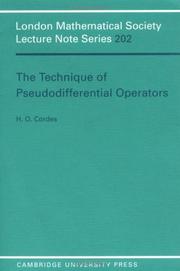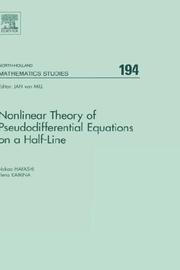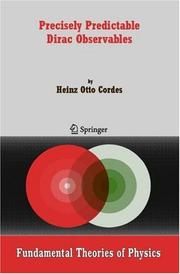| Listing 1 - 10 of 47 | << page >> |
Sort by
|

ISBN: 1139886312 1107366496 1107371201 1107361583 1107368111 1299404278 1107364035 0511569424 9781107361584 0521378648 9780521378642 9780511569425 Year: 1995 Publisher: Cambridge [England] ; New York : Cambridge University Press,
Abstract | Keywords | Export | Availability | Bookmark
 Loading...
Loading...Choose an application
- Reference Manager
- EndNote
- RefWorks (Direct export to RefWorks)
Pseudodifferential operators arise naturally in the solution of boundary problems for partial differential equations. The formalism of these operators serves to make the Fourier-Laplace method applicable for nonconstant coefficient equations. This book presents the technique of pseudodifferential operators and its applications, especially to the Dirac theory of quantum mechanics. The treatment uses 'Leibniz formulas' with integral remainders or as asymptotic series. A pseudodifferential operator may also be described by invariance under action of a Lie-group. The author discusses connections to the theory of C*-algebras, invariant algebras of pseudodifferential operators under hyperbolic evolution and the relation of the hyperbolic theory to the propagation of maximal ideals. This book will be of particular interest to researchers in partial differential equations and mathematical physics.
Book
ISBN: 1281788678 9786611788674 0080875459 0444881379 9780444881373 9780080875453 9781281788672 Year: 1991 Publisher: Amsterdam New York New York, N.Y., U.S.A. North-Holland Sole distributors for the United States and Canada, Elsevier Science Pub. Co.
Abstract | Keywords | Export | Availability | Bookmark
 Loading...
Loading...Choose an application
- Reference Manager
- EndNote
- RefWorks (Direct export to RefWorks)
The analysis of differential equations in domains and on manifolds with singularities belongs to the main streams of recent developments in applied and pure mathematics. The applications and concrete models from engineering and physics are often classical but the modern structure calculus was only possible since the achievements of pseudo-differential operators. This led to deep connections with index theory, topology and mathematical physics. The present book is devoted to elliptic partial differential equations in the framework of pseudo-differential operators. The first chapter contains t
Book
ISBN: 2759802825 1417562129 9781417562121 6611258361 9786611258368 Year: 1991 Publisher: Paris : InterEditions,
Abstract | Keywords | Export | Availability | Bookmark
 Loading...
Loading...Choose an application
- Reference Manager
- EndNote
- RefWorks (Direct export to RefWorks)
Outil de base dans les domaines des équations aux dérivées partielles et de l'analyse sur les variétés, les opérateurs pseudo- différentiels permettent de porter un regard neuf sur la méthode de perturbation de Nash et Moser. Analyse microlocale, théorie de Littlewood-Paley, inégalités d'énergie pour les équations hyperboliques et théorèmes de fonctions implicites sont abordés.
Book
ISBN: 3031283988 303128397X Year: 2023 Publisher: Cham, Switzerland : Springer Nature Switzerland AG,
Abstract | Keywords | Export | Availability | Bookmark
 Loading...
Loading...Choose an application
- Reference Manager
- EndNote
- RefWorks (Direct export to RefWorks)
This book presents original research results on pseudodifferential operators. C*-algebras generated by pseudodifferential operators with piecewise smooth symbols on a smooth manifold are considered. For each algebra, all the equivalence classes of irreducible representations are listed; as a consequence, a criterion for a pseudodifferential operator to be Fredholm is stated, the topology on the spectrum is described, and a solving series is constructed. Pseudodifferential operators on manifolds with edges are introduced, their properties are considered in details, and an algebra generated by the operators is studied. An introductory chapter includes all necessary preliminaries from the theory of pseudodifferential operators and C*-algebras.
Book
ISBN: 9780821884874 0821884875 Year: 2013 Publisher: Providence, R.I. American Mathematical Society
Abstract | Keywords | Export | Availability | Bookmark
 Loading...
Loading...Choose an application
- Reference Manager
- EndNote
- RefWorks (Direct export to RefWorks)
Book
ISBN: 3030291235 3030291227 Year: 2019 Publisher: Cham : Springer International Publishing : Imprint: Springer,
Abstract | Keywords | Export | Availability | Bookmark
 Loading...
Loading...Choose an application
- Reference Manager
- EndNote
- RefWorks (Direct export to RefWorks)
This book explores various properties of quasimodular forms, especially their connections with Jacobi-like forms and automorphic pseudodifferential operators. The material that is essential to the subject is presented in sufficient detail, including necessary background on pseudodifferential operators, Lie algebras, etc., to make it accessible also to non-specialists. The book also covers a sufficiently broad range or illustrations of how the main themes of the book have occurred in various parts of mathematics to make it attractive to a wider audience. The book is intended for researchers and graduate students in number theory. .
Number theory. --- Algebraic geometry. --- Number Theory. --- Algebraic Geometry. --- Pseudodifferential operators. --- Algebraic geometry --- Geometry --- Number study --- Numbers, Theory of --- Algebra --- Operators, Pseudodifferential --- Pseudo-differential operators --- Operator theory
Book
ISBN: 3110250314 9783110250312 9783110250305 Year: 2012 Publisher: Berlin : De Gruyter,
Abstract | Keywords | Export | Availability | Bookmark
 Loading...
Loading...Choose an application
- Reference Manager
- EndNote
- RefWorks (Direct export to RefWorks)
This textbook provides a self-contained and elementary introduction to the modern theory of pseudodifferential operators and their applications to partial differential equations. In the first chapters, the necessary material on Fourier transformation and distribution theory is presented. Subsequently the basic calculus of pseudodifferential operators on the n-dimensional Euclidean space is developed. In order to present the deep results on regularity questions for partial differential equations, an introduction to the theory of singular integral operators is given - which is of interest for its own. Moreover, to get a wide range of applications, one chapter is devoted to the modern theory of Besov and Bessel potential spaces. In order to demonstrate some fundamental approaches and the power of the theory, several applications to wellposedness and regularity question for elliptic and parabolic equations are presented throughout the book. The basic notation of functional analysis needed in the book is introduced and summarized in the appendix. The text is comprehensible for students of mathematics and physics with a basic education in analysis.
Pseudodifferential operators. --- Integral operators. --- Operators, Integral --- Integrals --- Operator theory --- Operators, Pseudodifferential --- Pseudo-differential operators --- Application. --- Functional Analysis. --- Partial Differential Equation. --- Pseudodifferential Operator. --- Singular Integral Operator.

ISBN: 9780444515698 0444515690 Year: 2004 Publisher: Amsterdam Boston Elsevier
Abstract | Keywords | Export | Availability | Bookmark
 Loading...
Loading...Choose an application
- Reference Manager
- EndNote
- RefWorks (Direct export to RefWorks)
Book
ISBN: 1108100104 1316986705 1108102905 9781108102902 9781316986707 9781107188822 1107188822 Year: 2018 Publisher: Cambridge : Cambridge University Press,
Abstract | Keywords | Export | Availability | Bookmark
 Loading...
Loading...Choose an application
- Reference Manager
- EndNote
- RefWorks (Direct export to RefWorks)
Starting from physical motivations and leading to practical applications, this book provides an interdisciplinary perspective on the cutting edge of ultrametric pseudodifferential equations. It shows the ways in which these equations link different fields including mathematics, engineering, and geophysics. In particular, the authors provide a detailed explanation of the geophysical applications of p-adic diffusion equations, useful when modeling the flows of liquids through porous rock. p-adic wavelets theory and p-adic pseudodifferential equations are also presented, along with their connections to mathematical physics, representation theory, the physics of disordered systems, probability, number theory, and p-adic dynamical systems. Material that was previously spread across many articles in journals of many different fields is brought together here, including recent work on the van der Put series technique. This book provides an excellent snapshot of the fascinating field of ultrametric pseudodifferential equations, including their emerging applications and currently unsolved problems.

ISBN: 1280744030 9786610744039 1402051697 1402051689 Year: 2007 Publisher: Dordrecht ; [Great Britain] : Springer,
Abstract | Keywords | Export | Availability | Bookmark
 Loading...
Loading...Choose an application
- Reference Manager
- EndNote
- RefWorks (Direct export to RefWorks)
This work presents a "Clean Quantum Theory of the Electron", based on Dirac’s equation. "Clean" in the sense of a complete mathematical explanation of the well known paradoxes of Dirac’s theory, and a connection to classical theory, including the motion of a magnetic moment (spin) in the given field, all for a charged particle (of spin ½) moving in a given electromagnetic field. This theory is relativistically covariant, and it may be regarded as a mathematically consistent quantum-mechanical generalization of the classical motion of such a particle, à la Newton and Einstein. Normally, our fields are time-independent, but also discussed is the time-dependent case, where slightly different features prevail. A "Schroedinger particle", such as a light quantum, experiences a very different (time-dependent) "Precise Predictablity of Observables". An attempt is made to compare both cases. There is not the Heisenberg uncertainty of location and momentum; rather, location alone possesses a built-in uncertainty of measurement. Mathematically, our tools consist of the study of a pseudo-differential operator (i.e. an "observable") under conjugation with the Dirac propagator: such an operator has a "symbol" approximately propagating along classical orbits, while taking its "spin" along. This is correct only if the operator is "precisely predictable", that is, it must approximately commute with the Dirac Hamiltonian, and, in a sense, will preserve the subspaces of electronic and positronic states of the underlying Hilbert space. Audience: Theoretical Physicists, specifically in Quantum Mechanics. Mathematicians, in the fields of Analysis, Spectral Theory of Self-adjoint differential operators, and Elementary Theory of Pseudo-Differential Operators.
Dirac equation. --- Quantum theory. --- Pseudodifferential operators. --- Operators, Pseudodifferential --- Pseudo-differential operators --- Operator theory --- Quantum dynamics --- Quantum mechanics --- Quantum physics --- Physics --- Mechanics --- Thermodynamics --- Differential equations, Partial --- Quantum field theory --- Wave equation
| Listing 1 - 10 of 47 | << page >> |
Sort by
|

 Search
Search Feedback
Feedback About UniCat
About UniCat  Help
Help News
News